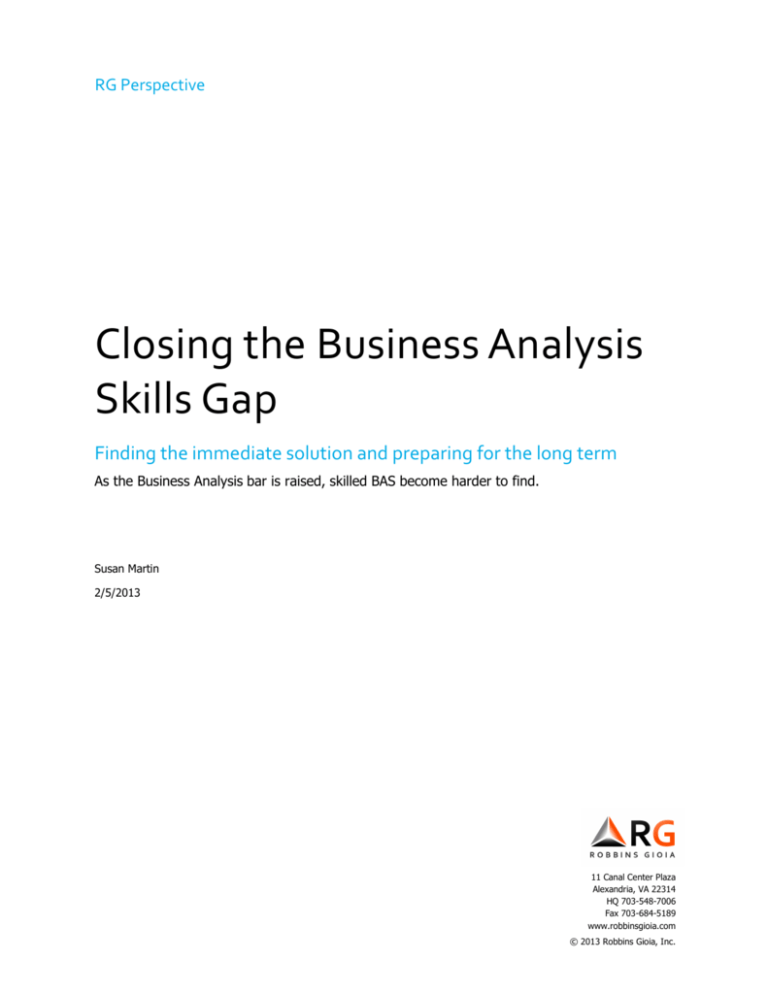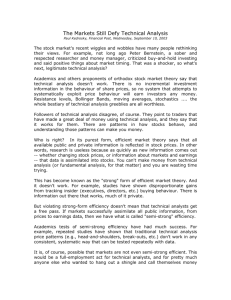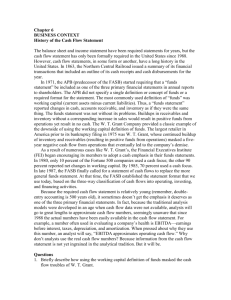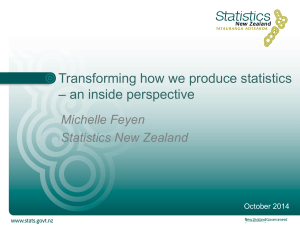Closing the Business Analysis Skills Gap
advertisement

RG Perspective Closing the Business Analysis Skills Gap Finding the immediate solution and preparing for the long term As the Business Analysis bar is raised, skilled BAS become harder to find. Susan Martin 2/5/2013 11 Canal Center Plaza Alexandria, VA 22314 HQ 703-548-7006 Fax 703-684-5189 www.robbinsgioia.com © 2013 Robbins Gioia, Inc. Closing The Business Analysis Skills Gap The recognition and growth of the business analysis profession has meant increased BA involvement throughout the system development life cycle. Business analysts have expanded their role and skill set, proving their value on projects of all types across the organization from business-process improvement efforts to application enhancements to product development. A recent search for business analysis jobs on a popular jobs site returned 149,289 job postings; clearly the demand for BAs far outpaces the supply. This paper discusses why the task of finding skilled business analysts has become a problem for so many organizations and suggests some effective solutions. Not All Business Analysts Are Created Equal In the past, many employees with different roles used the title of “business analyst” regardless of their duties, background or skill set. We have found “business analysts” who are data analysts or technically-focused systems analysts or even technical writers. Today, the International Institute of Business Analysts (IIBA®) has helped to define the practice of business analysis both more carefully and more thoroughly and has built the Business Analysis Body of Knowledge® (BABOK® Guide) that lays out the knowledge areas critical to the business analyst. This guide has become the accepted standard for the BA profession. Yet, while the BABOK Guide contains invaluable information, it's not a step-by-step process that BAs can follow. In other words, knowledge of the Guide’s contents alone is not enough to ensure success. Analysts who can actually execute the BA role as outlined by the BABOK and the IIBA are few and far between. As the profession becomes more prominent and business analysts are seen as crucial members of any 1 Business Analyst Competencies • • • • • • • • • • • • Elicitation and Facilitation Modeling Techniques Writing Skills Communication Clarity Analytical Approach Problem Solving Leadership Team Orientation Planning Requirements Management Multi-Tasking Experience project team, the BAs currently in an organization may not have the skills or background necessary to successfully execute important projects. Or, as is often the case, there are simply not enough business analysts to meet project demands. Organizations may be forced to use unqualified resources or go without an important strategic resource altogether. An Immediate Solution and Preparing for the Long Term Companies that need business analysts can find it difficult to attract and retain skilled project-tested talent. However, even when there is a shortage of resources, the work must be done. The result can be to rely too heavily on the expertise of a select few over-worked, business analysis “all-stars.” This lack of bench strength will cripple an organization as key analysts become too heavily allocated, or worse, leave the company. Closing the business analysis skills’ gap requires that companies look beyond the walls of their organization to acquire business-analysis talent to staff immediate needs. At the same time, they can work toward establishing a support structure necessary to grow business analysts internally. It’s a dual approach: a combination of strategic outsourcing accompanied by Closing The Business Analysis Skills Gap organizational improvement with the objective of developing bench strength. Step 1: Use a Managed Business Analysis Solution to Staff Critical Projects Finding, attracting and signing top talent into full-time roles is difficult and expensive. Usually projects must If you determine you need outside expertise, finding a managed business-analysis solution can be the best path to obtain world-class’ business analysis expertise to meet immediate staffing needs. The business analyst team from a managed solution will come ready to contribute to project success on day one with: • Vetted, project-tested business analysts be staffed immediately with highly productive business analysts. As a near term solution, the business analysis • A proven requirements methodology skills gap can be closed by working with a specializedcontractor to provide a managed business-analysis • Industry standard modeling and management tools solution using best-of-breed business analysis talent. When does it make sense to outsource? Not every job can be handled internally; in the same way, not all jobs need outside help. How do you determine if it’s worthwhile for you to outsource some or all of your BA functions? The best strategy is to start by asking three critical questions: Your management may need some evidence that using BA resources from an outside source makes sense. Here’s what we’ve found: Reason #1: Outsourcing can lower the risks and improve the outcomes of large IT initiatives. Are you searching for a skill set that is routine for your Requirements are much too important not to do right. organization? This is borne out by the dismal results of industry studies and surveys. Some key metrics: If you have many BAs that are up-to-date with the latest techniques and have handled similar projects, then you are likely to be able to find internal resources 31% of all software projects are canceled before completion ($81B wasted) Source: Standish or hire good candidates for your needs. Chaos Report Are the upcoming projects somewhat different and/or 53% of projects will cost 189% of estimates Source: more high profile than usual? Standish Chaos Report If the projects you need BAs for are outside the comfort zone of your current staff, you could benefit from outsourcing the BA role to a more experienced organization. Have you had complaints from either the business or IT side of the house as to the quality of requirements? In this case, you’ll definitely want to take advantage of using outside expertise so that new projects can be staffed quickly and with a high level of skills – skills that can be transferred to your internal staff as they work as part of the project team. 2 The challenges of software development projects used to be the technology and the availability of skilled people to implement the technology. This was particularly true when software applications were written from scratch. the case. But today this is no longer The challenges we face today are understanding how we can best make use of information technology to improve the effectiveness and competitiveness of our business. Implementing technology without understanding fully the business problem your users need to solve is a Closing The Business Analysis Skills Gap fast track to disaster. This means understanding the process modeling and requirements analysis that will requirements from the business point of view. allow it to more effectively fulfill its mission. Reason #2: Business analysis/ requirements Reason #4: Outsourcing can extend your outsourcing can bring new best practice requirements analysis into business processes techniques to your organization. and help identify cost effective opportunities for automation. Business processes in most organizations grow increasingly complex year by year due to competitive pressures to add new products and services, regulatory Many IT-driven requirements projects focus on narrow feature/function issues of a system. Typically this compliance, expansion through growth or acquisition, and any number of reorganizations. The touch points includes Use Cases or Joint Application Development sessions that focus on issues such as the user interface between information systems and business processes have also increased as more and more manual tasks are (screens for query, update and data entry), report layouts, security requirements and other design- automated. This makes the job of understanding business operations much more complex. The skill level oriented features of the system. While these requirements are important for technical specification required by a business analyst today is much higher than it was even five years ago. and detailed design, they do not show how the system is supposed to support a business process. IT often The methods of gathering and documenting requirements that worked five years ago may not be effective today because of the increasing complexity of the business and the wider range of technologies for automating business processes available. An outsourcing partner that specializes in requirements analysis and business process modeling will be able to introduce new practices to your organization at the project level, helping internal resources to understand how they can be used successfully. Reason #3: Outsourcing can bridge the gap between the IT organization and the business organization. In many companies the responsibility for requirements analysis and business process modeling is pushed back and forth between the business units and the IT organization. Many companies are creating a Program Management Office (PMO) that reports to the COO or VP of Operations and attempts to bridge the communications gap between business management and IT systems designers. It is not an easy void to fill. Each group has its own culture and mode of approaching issues. An outsourcing partner can help the PMO develop systematic methods for business 3 presumes that the users know exactly what type of system they need, and the only open question is how the system should look and function. But the best solutions are not always technical or expensive. An outsourcing partner skilled in business process modeling can help you identify where and how you can get the best return on your investment in business process automation. Reason #5: Outsourcing can be a cost effective way to get the skills you need when you need them (even when you don’t think you do) It can take years to develop the skills needed to do rigorous business process models and business and systems requirements. It is a skill that is developed best through a broad range of projects and system initiatives. An outsourcing partner can bring those skills and experiences to your organization when you need them on a project by project basis or as an ongoing partnership. A Checklist for Outsourcing Not all outsourcing vendors are the same, of course. Unfortunately most vendors boast that they have business analysts when what’s really needed is Closing The Business Analysis Skills Gap experience in the discipline of business analysis. Here is a checklist that will help you separate the ‘walk’ from the ‘talk’: • Is the consultancy aligned with an accredited business analysis organization (i.e. IIBA) with accredited analysts that will be “on site” at your organization? • Can the consultancy provide evidence that all consultants are trained on the same analysis • Does the approach consultancy that provide considers an tools integrated and method together? • Can they adapt business analysis techniques to tools used by your organization, or recommend the right tool for your specific needs? A consulting vendor should meet all of the criteria above in order to help competency gap. your organization address its methods which will be used for your organization? • Can the consultancy cite their experience in other industries besides your own where they have helped BA best practices be adopted successfully? • Can the consultancy demonstrate business analysis capability at the strategic, project, and technical levels? • Is the stated goal of the consultancy to enable best Step 2: Build a Business Analysis Center of Excellence to Grow Business Analysis Skills Internally Having standout analysts on a project – whether internally or externally sourced - can lead to success, but individual business analysts often struggle to make lasting improvements and need support to bring about the change necessary to make meaningful, lasting organization-wide improvements. practice within your organization so that you can be A center of excellence targeted to support the business effective after they depart? analysis discipline can advance BA skills, increase the quality of requirements and, ultimately, improve the quality of delivered solutions. This approach to building 4 Closing The Business Analysis Skills Gap expertise makes it is possible to raise project success rates and grow business-analyst talent in-house while taking steps to improve the quality and consistency of requirement deliverables. A Business Analysis Center of Excellence (BACoE) functions as a focus of developing business analysis expertise and growing the skills of business analysts. It typically has responsibility for several key disciplines. Requirements Processes and Deliverables Requirements Analytics The BACoE works with project teams to identify base metrics (usually in the form of a scorecard) that will measure the business value of the requirements and requirements processes to the organization, and reports out to other organizations on this information. Once established, the BACoE becomes the avenue for The BACoE serves as the owner of the processes that continuous improvement and helps ensure that an organization can adapt to changing demands and meet will be followed during the requirements life cycle. That means defining the processes, ensuring that they are the needs of their customers. In fact, it can become a key contributor to achieving a high level of maturity kept up-to-date with lessons learned and best practices, and making them available to help ensure all BAs know within the application development organization. what to do. Business Analysis Maturity Is the Goal Business Analyst Professional Development The Software Engineering Institute has developed a Capability Maturity Model (CMM) that shows an effective The BACoE, in conjunction with HR, is responsible for defining a business analyst career path, defining essential skills and establishing a training curriculum for professional development. As a CIO recently said: “Users have trouble expressing their needs and desires in a way that the technologist can understand. There must be someone in the middle to interpret what the user is saying and translate it to IT.” approach toward improving an organization's software development processes. It has become clear that the model can be applied to other processes as well, particularly the requirements life cycle processes. The maturity model is a set of structured levels that describe how well the behaviors, practices and processes of an organization can reliably and sustainably produce required outcomes. The CMM has The goal of the BACoE is to develop business analysts who can be that ‘someone in the middle’ and can speak five levels where the uppermost (5th) level is an “ideal” state where processes would be systematically managed the language that will communicate to all. by a combination of process continuous process improvement. optimization and Tool and Asset Management This is exactly what a BACoE is intended to do. It documents the processes for business analysis, The BACoE researches and manages the tools that business analysts can use for requirements elicitation, requirements analysis, and requirements management so that they are repeatable (Level 2 of the CMM) and so documentation, and management. In addition, the BACoE is the central point for managing the repository that they are defined (Level 3 of the CMM). It helps to manage the process (Level 4 of the CMM) by defining of assets created during project execution. These assets must be organized in a way that makes them metrics and it supports continuous optimization of the process (Level 5 of the CMM). available to jump-start subsequent projects and to contribute toward building an enterprise-wide view of the business. 5 Closing The Business Analysis Skills Gap For these reasons, the development of a BACoE Your Path to Closing the BA Skills Gap provides strong advantages and can be seen as a positive differentiating factor for an organization. Closing the business analysis skills gap should be a top priority for any organization looking to increase its How Do You Get There? project success rates, and to grow and improve its business. Using a two-pronged approach that Building a Business Analysis Center of Excellence can’t be done overnight. But there are a few important lessons that we’ve learned as we’ve working with our clients to establish their BACoE organizations: Starting up a best-practice organization requires a champion at the executive level to market and drive it. Without a champion at a high level, BACoE efforts can incorporates highly skilled business analysts on the one hand in order to realize immediate project success, and the development of a BACoE on the other in order to build future in-house competency, speeds implementation and ensures that projects are staffed with top-notch analysts equipped with the right process and tools every time. quickly fall to the bottom of the list of priorities. Developing a BACoE should be treated as a project in About the Author and of itself, with a set of goals, a timeline, dedicated resources and a business case. Building the business Susan Martin Susan is a founding member of DEA case will help ensure the organization understands there is real value to having a BACoE – value that can be seen in reduced training costs on the one hand and improved quality (and fewer problem logs) on the other. and currently serves as its Executive Vice President for Business Analysis Competency. In this position, she provides more than 20 years of experience in planning Do an assessment of your “as-is” state. You won’t be able to build your vision or know what you need to do and delivering implementation services and is accountable for the development of methodologies and or how long it will take without understanding your current situation. The assessment lays the groundwork course materials and oversees the quality of deliverables produced by project teams during client for your implementation plan and your expectations for change. engagements. She also serves as product manager for the LINK™ suite of processes and tools. Susan is a Plan on a two- to three-year effort, with building blocks along the way. It takes time to gather the expertise and learn how to function as a key part of the larger organization. Incorporate outside help. At the very least, an outside organization can help you see where you are now and lay out a plan for how to get where you want to go. An outside organization can provide other benefits as well. Perhaps most important – they’ve done it before. It will pay dividends in time, effort and enthusiasm to avoid mistakes and learn from practitioners with realworld experience. 6 trained facilitator and has conducted many sessions in process redesign, business requirements development and business rules identification. About Robbins Gioia RG is a recognized leader in program management services, dedicated to helping organizations optimize business processes, accelerate change, and establish lasting quality improvements. Headquartered in Alexandria, VA, we deliver groundbreaking management solutions to public and private sector clients across the globe.








